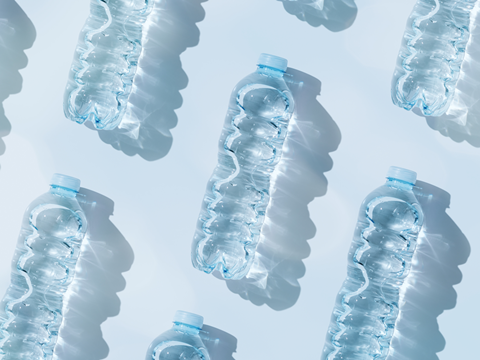
With fewer than three months to go until the EU’s 2025 target for 25% recycled content in PET bottles comes into effect, the market faces ‘chaos’ amid uncertainty. Caroline Murray, Senior Editor at ICIS, takes a closer look at the key issues.
There are just over 70 days to go before all EU countries must include 25% recycled content in polyethylene terephthalate (PET) beverage bottles, yet the market was described as being in ‘chaos’ due to huge levels of uncertainty around the single-use plastics directive.
Speaking at the International Gate Summit, ICIS senior editor for recycling Matt Tudball said: “EU member state clarity on penalties has the potential to be a game-changer.”
Targets set out by the directive include:
- 77% separate collection for bottles by 2025, rising to 90% by 2029
- 25% mandatory recycled content in PET bottles from 2025
- 30% mandatory recycled content in plastic bottles from 2030
With less than three months until the 2025 target comes into effect, the industry is unclear on penalties for not reaching this goal.
To date, no member state has clearly laid out what will happen if beverage brands do not increase recycled PET (R-PET) to 25%, but if one or more of them does, this could be the catalyst that drives more converters, preform producers and beverage brands to the R-PET market, Tudball said.
It is also unclear how each country will audit the volume of recycled material being used in bottles.
Some member states have said they will calculate the 25% recycled content by bottle, some by manufacturer, and some as an average of all beverage bottles placed on the national market each year. This could cause major planning headaches for any beverage brand that places bottles in multiple countries if the rule per country is different.
“Penalties need to be sizeable to entice action,” Tudball said, citing the UK’s Plastic Packaging Tax as an example of what not to do.
The tax was £200/tonne when it first came into law in 2022 but did little to dissuade some buyers to move away from virgin plastics.
Due to the higher costs of recycled polymers such as R-PET colourless flakes, many simply paid the tax and used virgin PET because it was still a cheaper option than purchasing R-PET.
The industry has already invested heavily in recycling and this has become a burden for some.
“Costs became an issue, and capacity is being idled as a result,” a polymer consultant and agent said on the sidelines of the conference.
Nevertheless, there has been a lack of investment in collection and sorting systems across Europe.
European bureaucracy is thwarting competitiveness in R-PET, making it difficult for member states to access sufficient capital to innovate, Antonello Ciotti of Petcore Europe said.
In such tumultuous times and for circularity to succeed, it is imperative that the R-PET industry receives certainty from the EU member states on penalties for non-compliance.
PET resins can be broadly classified into bottle, fibre or film grade, named according to the downstream applications. Bottle-grade resin is the most commonly traded form of PET resin and it is used in bottle and container packaging through blow moulding and thermoforming.
Fibre grade resin goes into making polyester fibre, while film-grade resin is used in electrical and flexible packaging applications. PET can be compounded with glass fibre for the production of engineering plastics.
If you liked this story, you might also enjoy:
The ultimate guide to the Packaging and Packaging Waste Regulation in 2024
How are the top brands progressing on packaging sustainability?
Sustainable Innovation Report 2024: Current trends and future priorities
Everything you need to know about global plastic sustainability regulation


















No comments yet